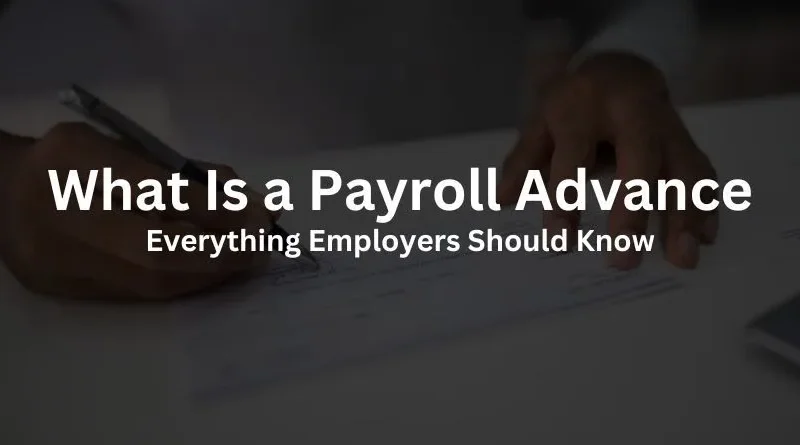What Is a Payroll Advance? Everything Employers Should Know
Giving your employees a payroll advance simply means giving them early access to their pay checks with predetermined terms (usually due to an unexpected incident). In essence, it works like a short-term loan that workers pay back with subsequent pay check deductions. You should carefully evaluate legal restrictions, taxes, and alternatives before presenting this choice to your workforce.
What to Consider Before Issuing Payroll Advances
Payroll advances can help employees and garner goodwill for your company. Before you act, however, it’s important to consider the implications.
Administrative Burden
The pressure that a payroll advance could put on your payroll staff should be taken into account initially. Payroll advances may become too much for a tiny payroll staff. Because of this, many businesses choose not to provide them.
Time-consuming and intricate tracking is required for each advance given to an employee. You must make sure that all local, state, and federal taxes are accounted for and that accurate records are kept. Your organization runs the danger of noncompliance violations if improperly handled.
Federal & State Laws
Payroll advances are an exemption to the federal rule that forbids deductions from paychecks that would bring an employee’s compensation below the minimum wage. Your business has the right to deduct funds from an employee’s salary at rates that might bring their compensation below the minimum wage if they owe you money as a result of a payroll advance. Check your state and local legislation because this is a federal exemption and some states do not permit this activity.
Only a few things, including taxes and benefits, are allowed to be taken out of an employee’s compensation under federal law. Before beginning any deduction for a cause not covered by federal or state law, you must obtain the employee’s written agreement.
Check out our state payroll guides for additional details on your state’s rules regarding payroll advances. They cover everything, including labor regulations and the minimum wage, and even offer state-specific resources if you want any further guidance:
You may also like reading: KMSPico: how to download and use to activate Microsoft Office 2010, 2013, 2016 and 365
Rates of Interest
If you’re providing an advance of more than $10,000, you should research the federally accepted rate for personal loans and think about using that rate. Every month, the IRS adjusts the relevant federal rates.
You must recognize the difference as taxable income to the employee if you charge 3% when the federal rate is 6% (more computations, more paperwork). Make sure to include for administrative expenses in your estimate because the IRS will treat all fees as interest.
How to Manage Payroll Advances

You must develop and oversee the procedure because it is your job to implement a payroll advance. You should include a representative if you’re utilizing a payroll service to make sure all transactions are recorded correctly. You may mark an off-cycle payment as an advance and schedule the amount to be withdrawn as a payback from the employee’s next paycheck (or next several paychecks, depending on how much you pay out) with the use of certain providers’ tools, which can help you handle this more effectively.
You should be aware that you will be required to cover any payroll advances, thus assuming all of the risk. You will need to assess the expenses of firing the employee (the likelihood of you getting reimbursed declines) vs giving them a chance to improve—at least until you get the money back in the event that their performance continues to deteriorate or they do a no-call, no-show one day.
Consider the following while creating your payroll advance policy:
- How frequently will workers be allowed to accept advances? We suggest imposing stringent restrictions on this, limiting it to no more than once a year.
- Which workers will be qualified? Due to their lower income and the length of time it would take them to return the loan, your part-time employees might not be eligible.
- What is the maximum advance an employee may receive? The employee’s paycheck should technically be the maximum amount for a payroll advance.
- Will you impose fees or interest? You can, but you must be careful how much you do so since you are not permitted to profit from the exchange.
Above all, a formal agreement between you and the employee is required in order to get a payroll advance. The details of the advance payment are outlined in this paper, as well as the payroll deduction plan.
Make sure the following details are included in the paycheck advance repayment agreement:
- The employee’s name
- The date of the payroll advance and amount
- The date of the first deduction, if more than one, and the frequency of deductions
- The amount of the deduction
- The company’s right to collect any remaining balance if the employee is no longer employed
When to Offer a Payroll Advance
Typically, when an employee asks one, a business will first think about providing one. However, if you take the initiative, you may create your policy and be prepared when an employee submits a request.
Here are a few typical justifications why workers could ask for a paycheck advance:
- A sudden medical bill
- Car repairs
- Emergency financial situation
- Poor credit reducing their ability to get a traditional loan
You have the option to ask the staff why, and you should. Your business can distinguish between valid and erroneous claims. After instance, requesting a payroll advance to pay for a new TV is very different than doing so to cover an unanticipated medical need.
Pros of Payroll Advances
- Relief for employees suffering financial hardship
- Increased employee loyalty
- Additional benefit for employees
Cons of Payroll Advances
- Added administrative costs
- Employees may need additional funds
- Potential for abuse if not properly monitored
It’s crucial to remember that if an individual leaves their job or is fired, you can have problems getting your money back. This is why having a formal contract in place is essential. You have a legally enforceable contract that gives you the right to take legal action even if an employee resigns. It may be against state law to attempt to deduct the whole outstanding sum from a terminated employee’s final pay check.
Payroll Advance vs Employee Loan

Technically, a payroll advance is a debt to the employee. What makes a difference, then?
A payroll advance is fundamentally different from an employee loan in that it pays the employee’s compensation in advance of payday. The advance must be repaid by payroll deductions from the employee. An employee loan, on the other hand, can entail bigger quantities of money that are returned over a longer time.
For workers who want immediate access to money, a payroll advance is frequently the best option. An employee loan could be more appropriate for people who don’t want huge quantities of money that they will return through payroll deductions over a longer period of time but don’t require urgent cash.
Conclusion
The optimum use for payroll advances is for major crises that can’t be resolved with a single payment. We’re not advocating giving a worker making $10 an hour a $10,000 advance, but $1,000 would be appropriate. Advances assist your employees in overcoming financial difficulties, but they should only be used in certain circumstances. Additionally, because they are short-term loans, they are only given to workers.




